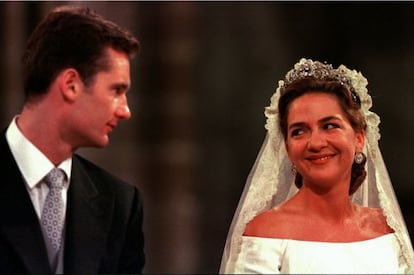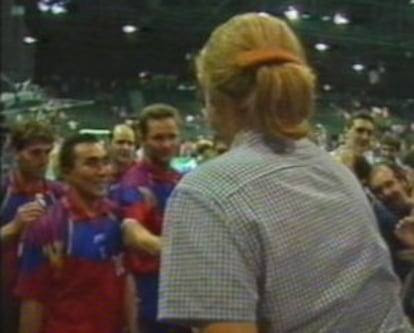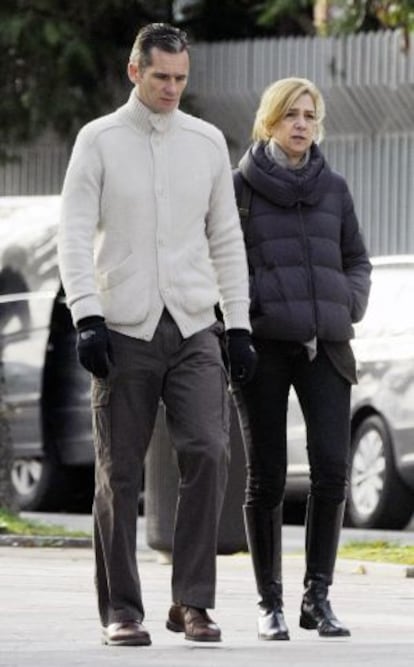How an ideal couple’s life went to hell
Officially, the marriage of Princess Cristina and Iñaki Urdangarin was an idyllic union But the Nóos inquiry court papers paint a very different picture

Yes, it’s true. Iñaki Urdangarin was the perfect athlete, the perfect boyfriend, the perfect husband, the perfect father and the perfect son-in-law; he was one half of an ideal marriage that produced an officially happy couple. Until he suddenly stopped being perfect.
Those days are not so hard to remember. Iñaki was tall, personable, blond and athletic — an Olympic athlete at that; in fact, an Olympic medalist. He was the heart and soul of the most successful team ever seen in Spanish handball. Furthermore, he was the offspring of a nice Catholic family with Basque origins and Catalan connections. Cristina was a princess, noble by birth but endowed with a bourgeois sense of duty to one’s work, discreet, moderately independent, modern, and the first woman in the Spanish royal family with a university degree.
It would be hard to overestimate how much sugar poured out of the glossy magazines that gushed over a couple who represented a blessing for the monarchy of the new century. Until the advent of Letizia, Crown Prince Felipe’s wife, a woman with a strong character and a more earthly resume (she was a middle class divorcee who had worked in journalism), it was safe to say that Cristina and Urdangarin were the favorite couple at the royal palace, hands down.
The wedding took place in Barcelona, a city with a republican soul and no courtesan tradition. The couple led a normal life: she worked for La Caixa Foundation, and he was completing his studies at Esade, a top Spanish business school. The union was fertile, and there were four births in quick succession: Juan in 1999, Pablo in 2000, Miguel in 2002 and Irene in 2005. Everything that was written about the couple in those days helped consolidate the discreet charm of their normal, happy life. They were “exemplary,” a term that would later be used against them. But the fairy tale came to an end. The spell was broken.
The official version of the story, as drafted by La Zarzuela, underscored that Cristina and Urdangarin had originally had lots of friends in common: Vicky Fumadó, Fernando León, Luis Doreste — a combination of athletes and individuals of noble lineage. But a book titled Infanta Cristina, by Consuelo León Llorente and María Molina, two authors who lived and worked in Barcelona, dared to draw on less official sources. It turns out that the pair did not meet in 1996 as the Royal Household claimed, but in 1992. And that Cristina was obsessed with Iñaki.
“She is a stubborn, obsessive woman. She was obsessed with him. Iñaki had serious doubts, he was very indecisive about the relationship and even dated her and Carmen Camí simultaneously for a while, but she was bent on marriage,” says one of these unofficial sources.

But such details were carefully ignored at the royal palace. Iñaki Urdangarin went on to get an MBA at Esade, where he had a study program tailor-made to suit his needs. Queen Sofía showed up for the graduation ceremony; it later emerged that he had never obtained his bachelor’s degree. Diego Torres, his business associate in the dubious dealings that got Urdangarin in hot water (and who was not his professor at Esade, contrary to what has been published), recommended that he complete his studies when business started to go badly. But that was years later.
There was another side to the couple's life — just like in any other couple’s life — as evidenced by material used in the legal investigation into Urdangarin’s activities. Certainly, some of the personal emails that have since emerged do not make Iñaki look like the ideal husband after all. The messages shed light on many previously unknown aspects of his professional activity and personal life, including his likes and dislikes, which he openly manifested in carelessly worded messages that were left behind in the hard drives of several computers.
And there they stayed even though every 15 days a few computer technicians who allegedly worked for the security services would drop by, clean out the drives and check the communications issuing from a business first known as Consultoría Noos, later Instituto Nóos and finally Fundación Deporte, Cultura e Integración Social. This supposed non-profit owned by Urdangarin and Torres in fact served to secure hefty no-bid contracts from the governments of Valencia and the Balearics, who paid for grossly overcharged services, the investigation shows.
These exchanges ended up in the power of Urdangarin’s former business partner, who later used them in his own defense during the ongoing criminal inquiry into their activities at the helm of Nóos. Both are believed to have diverted around six million euros in public money received by Nóos in the mid-2000s, money that ended up in tax havens and private companies owned by Torres, his wife (who is also being investigated), Urdangarin and Cristina de Borbón. These messages were a determining factor in Cristina finally being hauled in front of a judge to testify as to her own role in the case last Saturday.

There are compromising emails from late 2003 and early 2004, a particularly prosperous period in the life of Iñaki Urdangarin, whose Nóos Consultoría was doing very well and who was already taking his first steps in a hypothetical run for the presidency of the Spanish Olympic Committee (COE). This is also the time when he negotiated a five-million-euro loan from La Caixa to buy a splendid six-million-euro mansion in Pedralbes, an exclusive residential area in uptown Barcelona. It was right around then that the first rumors began to circulate about Urdangarin’s sudden prosperity and his ambition to chair the (COE) even though he had commercial interests with some of its sponsors.
But the gossip magazines only reflected the couple’s good fortunes. It was well known that they were happy accomplices to Crown Prince Felipe’s relationship with Letizia Ortiz before the latter’s marriage. Cristina and Iñaki covered for them and let them stay at their place, and Iñaki even agreed to go buy the engagement ring at Suárez, a prestigious jewelry shop. Despite what’s been printed, however, neither he nor his associate Torres paid for the ring.
“The advantage of a city like Barcelona for the royal couple is that the city was indifferent to these things. People knew nothing about them, and wanted to know nothing about them,” says a person once close to the pair.
But when Letizia joined the family following her marriage to Felipe in May 2004, it marked the beginning of the first family feuds.
Despite what’s been said, Cristina de Borbón did not dislike the protocol or her official activities as a princess. “Cristina not only liked official events, she actually prepared for them and always conducted herself very professionally. She was very good at that,” said sources close to the royal house. The problem was, Letizia wanted to relegate the princesses — Cristina and her older sister Elena — to secondary roles.
But the falling out was a slow process. Between 2003 and 2006, nothing of note took place in the lives of a family that brought sheen to the summers in Palma de Mallorca, where the Duke and Duchess of Palma went on vacation and where Urdangarin made business deals on the side. It was here that he played paddle tennis with regional premier Jaume Matas. In fact, the investigation into Urdangarin’s dealings with the Balearic government and the Nóos case as a whole began as a mere offshoot of a wider inquiry into the Matas administration that began in 2010, most notably regarding the construction of a sports arena with massive cost overruns that smelled of inflated contracts and illegal commissions.
Of course a few things had changed since 2003, but they were not general knowledge. Nóos Consultoría had become Instituto Nóos to make Urdangarin’s company sound more like a non-profit group. The board members included Princess Cristina and her royal secretary, Carlos García Revenga. “The change was made on the express recommendation of the Royal Household, following instructions by Revenga and José Manuel Romero, Count of Fontao, the king’s legal advisor,” says a former employee. Regarding Cristina’s role at Nóos, there is no question that she hired her friend Marta Mas as the interior decorator for Nóos’s offices.
But in March 2006, the royal palace asked Urdangarin to refrain from pursuing any further private business activities. By then questions had been raised in the Balearic regional assembly regarding excessively expensive events organized by Urdangarin and Torres. So Nóos was re-baptized Fundación Cultura, Deporte e Integración Social and Urdangarin made chairman of an advisory council, a merely decorative position. “They told him they’d find him boards to sit on, not to worry about the money, but he didn’t want to be like Marichalar [the former husband to Princess Elena] and he fell into a bit of a depression,” say former associates.
The couple’s life began to lose some luster, although outwardly everything seemed fine. Cristina was not happy at La Caixa, either, and her falling out with Letizia was growing increasingly obvious. Much has been written about the birthday party that Cristina organized for Urdangarin in January 2008, because there were many witnesses to the fact that Letizia was visibly isolated and disconnected from the other guests. Some people also reported a conversation between Felipe and Iñaki, in which the latter manifested his difficulties making the mortgage payments on the Pedralbes mansion, followed by soothing words by the crown prince.
Several board memberships fell into Urdangarin’s lap — Pernod, Altadis, Lagardère — as well as an executive position in Telefónica, until the move to Washington DC. “It’s not entirely true that they moved there exclusively to get Iñaki far away from Spain. Cristina was also unhappy at La Caixa,” says one source.
And then November 2011 came round. The Nóos case blew wide open: police entered the Instituto’s premises with a search warrant and took away compromising information. Everyone turned to see what Urdangarin would do. At first, there was only silence. Queen Sofía traveled to Washington amid rumors that her son-in-law would soon face preliminary charges, and she was criticized for her public show of support. The magic was gone. People were starting to turn their backs on Cristina and Iñaki.
Rafael Spottorno, who became head of the Royal Household on September 11, 2011, came out three months later with his famous statement about Urdangarin’s behavior being “less than exemplary.” Soon after that came the subpoena to testify before Judge Castro at the Palma courthouse.
The family moved back to Barcelona in September 2012 because Cristina insisted on it, despite entreaties by La Zarzuela to stay in some foreign country. By now Iñaki had asked for a leave of absence from Telefónica. Nobody wanted to have their brand associated with his name.
Events happened quickly after that, in what could be described as a descent into hell: in January 2013 the Royal Household pulled Urdangarin’s biography from its website, and late that same month the city council of Palma de Mallorca unanimously agreed to change the name of the Dukes of Palma Avenue.
But none of it can bring Cristina down, it seems. In private, the princess has manifested that Urdangarin has given her all kinds of explanations regarding the events mentioned in his email exchanges. She has decided to put up a common front with her husband, like people who are defending themselves from unfair treatment. But, as one of her lawyers said, she is not so much a woman in love as an inordinately proud person. In the summer of 2013 the family moved again, this time to Geneva. Life in Barcelona had become unbearable.
Tu suscripción se está usando en otro dispositivo
¿Quieres añadir otro usuario a tu suscripción?
Si continúas leyendo en este dispositivo, no se podrá leer en el otro.
FlechaTu suscripción se está usando en otro dispositivo y solo puedes acceder a EL PAÍS desde un dispositivo a la vez.
Si quieres compartir tu cuenta, cambia tu suscripción a la modalidad Premium, así podrás añadir otro usuario. Cada uno accederá con su propia cuenta de email, lo que os permitirá personalizar vuestra experiencia en EL PAÍS.
¿Tienes una suscripción de empresa? Accede aquí para contratar más cuentas.
En el caso de no saber quién está usando tu cuenta, te recomendamos cambiar tu contraseña aquí.
Si decides continuar compartiendo tu cuenta, este mensaje se mostrará en tu dispositivo y en el de la otra persona que está usando tu cuenta de forma indefinida, afectando a tu experiencia de lectura. Puedes consultar aquí los términos y condiciones de la suscripción digital.
More information
Archived In
Últimas noticias
David Bowie, the galactic thinker who encouraged us to break new ground
John Berger and the loss of rural culture
From police officer to bloodthirsty kidnapper: Terror in Mexico during the years of ‘The Ear Chopper’
Alain Aspect, Nobel laureate in physics: ‘Einstein was so smart that he would have had to recognize quantum entanglement’
Most viewed
- David King, chemist: ‘There are scientists studying how to cool the planet; nobody should stop these experiments from happening’
- Reinhard Genzel, Nobel laureate in physics: ‘One-minute videos will never give you the truth’
- Oona Chaplin: ‘I told James Cameron that I was living in a treehouse and starting a permaculture project with a friend’
- Mexico completes its trade shift with the entry into force of tariffs on China and countries without trade agreements
- Sinaloa Cartel war is taking its toll on Los Chapitos









































